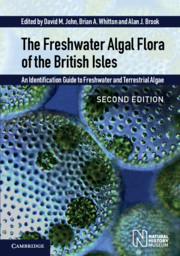 The Freshwater Algal Flora of the British Isles
The Freshwater Algal Flora of the British Isles Published online by Cambridge University Press: 12 January 2024
A small group of single-celled flagellates with two apical flagella differing in function and structure. One flagellum is directed forwards when cells are in motion, often longer than cell and easily visible; the second is thinner, rising close to the first but trailing, possibly acting as a rudder, initially in the apical groove. The large cells have no distinct wall and are often metabolic. Trichocysts or muciferous bodies are normally present in abundance just below the protoplast surface. Pigmented genera have numerous yellow-green, disclike chloroplasts containing chlorophylls a and c as well as several xanthophylls. The cells have oil as a storage product, an eyespot is usually absent, contractile vacuoles are numerous (sometimes in a prominent angular structure near apex), and the nucleus is large, sometimes with an endomembrane cap present.
Named the Chloromonadida by Klebs (1893) but changed to Rhaphidophyta by Bourrelly (1970), who believed the Chloromonadida could be confused with the genus Chloromonas (Chlorophyta, Volvocales). There are some similarities with the Cryptophyta, Pyrrophyta and Euglenophyta, but insufficient to warrant inclusion within any of them. Potter et al. (1997), on the basis of nucleotide sequencing, concluded that the Raphidophyceae are monophyletic, while 28S ribosomal sequencing had previously suggested affinities with the Chrysophyceae (Perasso et al., 1989). There are two families: Vacuolariaceae, containing photosynthetic genera, and the colourless Thaumatostigaceae, whose members have pseudopodia. Only the former family is considered here.
Nine genera are classified in the Raphidophyta and these occur in freshwater and marine habitats. Freshwater species are usually to be found in rather acid waters of some ponds and pools.
Some of the most important references on the phylum are Mignot (1967), Huber-Pestalozzi and Fott (1968), Bourrelly (1970), Spencer (1971),Heywood (1990) and Canter-Lund and Lund (1995).
The cells are extremely delicate and can be disrupted even by gentle pressure on a cover slip. Observation using ‘optical staining’, phase- or anoptral contrast is recommended.
To save this book to your Kindle, first ensure no-reply@cambridge.org is added to your Approved Personal Document E-mail List under your Personal Document Settings on the Manage Your Content and Devices page of your Amazon account. Then enter the ‘name’ part of your Kindle email address below. Find out more about saving to your Kindle.
Note you can select to save to either the @free.kindle.com or @kindle.com variations. ‘@free.kindle.com’ emails are free but can only be saved to your device when it is connected to wi-fi. ‘@kindle.com’ emails can be delivered even when you are not connected to wi-fi, but note that service fees apply.
Find out more about the Kindle Personal Document Service.
To save content items to your account, please confirm that you agree to abide by our usage policies. If this is the first time you use this feature, you will be asked to authorise Cambridge Core to connect with your account. Find out more about saving content to Dropbox.
To save content items to your account, please confirm that you agree to abide by our usage policies. If this is the first time you use this feature, you will be asked to authorise Cambridge Core to connect with your account. Find out more about saving content to Google Drive.